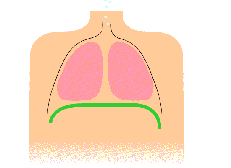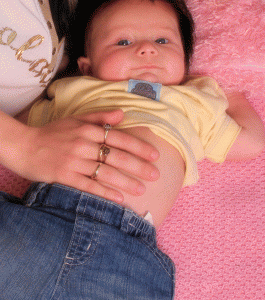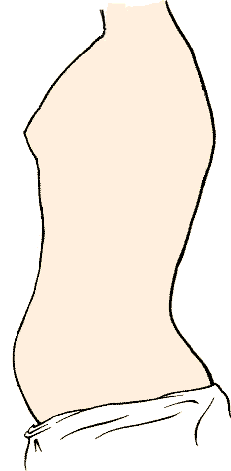Correct breathing technique. Do you breathe properly?
Contents
There will be some of you who have just clicked on the title of this article to see what the hell I mean by correct breathing technique. After all, you have been breathing your whole life and you’re still alive aren’t you? What could you possibly be doing wrong?
It may surprise you to learn that a lot of us just don’t breathe very well. Most people are also completely unaware that they have a problem. I assess each and every new client’s breathing technique when they first walk into my gym. Two out of every ten have forgotten how to breathe properly.
What do I mean by forgotten?
If you watch a baby breathing, you will notice their little belly ‘balloon out’ every time they breathe in. This is a perfect demonstration of correct breathing technique, namely ‘diaphragmatic breathing’.
In this article I will;
- Explain the effects that poor breathing has on your body.
- Share why I think we end up breathing improperly in the first place.
- Show you how you can test your breathing technique.
- Briefly explain correct breathing technique.
- Show you how to breathe properly which will:
- Help you avoid or prevent anxiety attacks / panic attacks.
- Help you control your levels of stress and get to sleep easier.
- Prevent overuse injuries to the muscles around your neck and chest.
- Help you become a more functional human being!
Correct breathing technique = Diaphragmatic breathing.
 The diaphragm (the green line) separates the heart and lungs from the rest of the abdomen. It basically turns the rib cage into a sealed unit. When the diaphragm contracts the space inside the rib cage is increased and the vacuum created pulls air into the lungs.
The diaphragm (the green line) separates the heart and lungs from the rest of the abdomen. It basically turns the rib cage into a sealed unit. When the diaphragm contracts the space inside the rib cage is increased and the vacuum created pulls air into the lungs.
Just like every other animal on this planet we don’t have to teach our young to breathe correctly, it’s instinctive.
Skip forward a few years however and diaphragmatic breathing has been replaced by shallow, chest breathing in some teenagers. Instead of the belly protruding out when they breathe in, the rib cage expands and the belly hollows (see Shallow chest breathing).
Try this simple test to check your breathing..
Diaphragmatic breathing test.
Stand up and put one hand flat on your belly and one on your chest. As you breathe in your belly should bulge gently against your hand, a bit like it’s inflating. Around 70% of the movement should be from your belly with chest movement making up the other 30%.
As you breathe out, your belly should return to normal like it’s deflating. If you find this isn’t happening try doing the test laying down on your back (this is usually easier).
So did you pass the test, do you breathe properly? Or does your breathing look more like the picture below?
Shallow chest breathing.
In this picture you will notice the chest expanding and the belly hollowing as the person breathes in. This is effectively breathing backwards!
When a person breathes in this way, they use the muscles in-between their ribs (intercostal muscles) to breathe instead of their diaphragm. The intercostal muscles lift each rib up in an arc like the handle lifting off the rim of a bucket. This increases the space inside the ribcage and the vacuum created pulls air in to the lungs.
People also often use the muscles around their neck and shoulders in an effort to expand the rib cage. This is again just another way of compensating for the diaphragm not working the way it should.
The problem with breathing this way is that these muscles don’t have the endurance to sustain this amount of work all the time.
These muscles end up getting ropey and twitchy because we are forcing them to do something they aren’t designed to do all the time. Breathing like this will mess your posture up and can lead to a whole host of aches and pains.
Breaths taken in this way are very shallow and the air only stays in the lungs for a very short period of time. This effectively changes the oxygen/carbon dioxide concentration of our blood and even it’s pH. This can lead to panic attacks, increased stress, insomnia and it may even elevate your blood pressure.
There are times when we need to utilize this method of breathing to get extra air in to our lungs. If you have just finished running, you may need to catch your breath. If you are pregnant you may end up breathing like this towards the end of your pregnancy.
But unless you are reading this wearing a corset or currently giving birth, you shouldn’t be breathing like this!
So why does this happen? Why do we seemingly forget how to breathe correctly? I don’t think anyone knows for sure why this happens, but I have my own theories.
Why can’t I breathe properly?
I am sure a respiratory expert can shed a lot more light on to why some of us end up breathing so poorly. I am not a respiratory expert and have learned about this subject through correcting my own poor breathing and that of clients over the years. Here however, are a few of my own theories.
◾Paranoia. Most of us are slightly paranoid about our bellies or about being overweight. We therefore, subconsciously end up shallow breathing as it reduces the amount our abdomen protrudes.
◾Stress. People tend to short quick breathes when they are stressed out. I have also often noticed people who breath like this tend to sigh a lot.
◾Sitting. I have already written other articles on the problems created by sitting too much (see here). Basically, its harder to breathe when sitting badly. Most of us sit with our backs rounded compressing the contents of out abdominal cavity. This means that it makes it harder for our diaphragm to work correctly.
If in any doubt, get yourself out by a doctor as there are some medical conditions that can lead to faulty breathing.
Learning to breathe properly.
Nearly all of us breathe properly when we are asleep. This is simply because our bodies have got us out of the way and gone back to working correctly. Learning to restore a good breathing pattern can take some time and a bit of practice. Here is a quick progression you can use to restore the pattern. This should be particularly helpful to people suffering with anxiety attacks / panic attacks.
When trying these breathing exercises bear the following points in mind:
- Breathe slowly and try to relax. Your body will not let you breathe too little!
- Breath in through your nose and all the way out through your mouth (this just makes it easier to learn for most people).
- Relax your neck and shoulders as much as possible.
- Try to gently inflate the lower part of your abdomen (belt level) as you breathe in.
- With the beginning exercises, try closing your eyes and practicing somewhere quiet.
- Start at step 1 and don’t progress to the next step until you are sure you have nailed it.
- Practice, practice, practice. Try to practice a couple of times per day minimum. Or even better as often as you can.
- If you suffer with panic / anxiety attacks you need to be patient. It can take 10-15 minutes of correct breathing before the fight or flight response calms down and the oxygen / carbon dioxide returns to normal.
(Step 1) On your front AKA Crocodile breathing.
This is the easiest one to start with. Lay on your stomach with your hand flat against your stomach. As you breathe the back of your hand should press against the floor. Continue practicing this until you feel you have mastered it before moving on to exercise (Step 2).
(Step 2) On your back.
Lay flat on your back with one hand on your belly and the other on the side of your chest on your ribs. Remember, as you breathe in 70-80% of the motion should be belly movement. If you struggle with this, some people find it helpful to put a book or small flat object on their belly. Simply watch it move up as you breathe in and down when you breathe out.
(Step 3) Standing.
This is usually the bit that takes the practice for most people. Stand up making sure you bring your hips under your lungs. Place your hands in the same place as (Step 2) and practice breathing in the same way.
(Step 4) Walking.
With your hands still on your belly and ribs, start slowly walking around the room. Really concentrate on trying to keep your neck and shoulders as relaxed as possible.
(Step 5) Sitting.
Sit down at your desk or on a kitchen chair/stool. As before, use your hands to monitor the movement. Imagine you have a piece of string attached to the centre of your scalp. Now imagine that the piece of string is gently being pulled up, lifting your upper body and straightening your back. You will notice that its easier to breathe correctly when you sit upright like this.
Breathing during exercises & stretches.
So what’s the best way to breathe when you are working out, stretching or playing sports? That entirely depends on the demands of the activity.
Breathing during stretches.
There are many different types and ways of stretching. Static stretches are when someone moves into a stretch and then holds the position at the end of their range of motion. For the vast majority of static stretches, I recommend that my clients brace their abs to ensure the stretch hits the target area without hurting their backs. For details on how to brace please see here. Once braced, they try to breathe diaphragmatically as described in this article.
Developmental stretches (such as PNF) attempt to increase someone’s range of motion. These can be done alone or with a partner. There are far too many types of developmental stretches to give all the details here. Generally though, it is often helpful to breathe in at the beginning of the stretch and then slowly out as you move further into it. Again, the abs should be braced throughout most stretches.
I also recommend avoiding holding your breathe or screwing your face up during stretching. Holding your breathe or gurning, can fool the body into thinking there is a threat which makes it tighten up to protect itself.
Breathing during weight training/lifting.
As a general rule of thumb I recommend that clients breathe out with the effort. For example, during a bench press, you breathe out as you push the weight from your chest and in on the way down. Again, bracing is vital throughout in order to protect your joints.
There are occasions when we have no alternative but to hold our breath during an exercise. If we deadlift, squat or bench press heavy then we need to try to create the maximum amount of stiffness in our trunks as we can. If you are going all out during a lift, its almost impossible not to hold your breathe at some point.
In order to get around this problem, we need to get our air in during the rest part of the lift. In the case of the deadlift, squat and bench press this is at the top of the movement. Breathe holding should only be required during maximal lifts and not during normal training.
Breathing during Aerobic exercise and sports.
During running, football or any other form of aerobic exercise our bodies need to take in a greater amount of oxygen. There will be times when your body will have to utilise a degree of chest breathing in order to accomplish this. It’s important to try to breathe diaphragmatically for as long as possible though. It can often be helpful to try and breathe out all your air at intervals during the activity. This often triggers a deeper abdominal breathe afterwards.
In closing.
I really hope this article helps people. I for one, found it really difficult to get good advice on this when I was younger.
As always, if you feel this could help someone you know please link to it or share it.
I would also like to share the following vid just because it made me laugh.


I’m delighted to have found your website. I was just reading about your articles about Core stability and Abdominal bracing (and I will get Dr McGill’s book, thank you). I’m passionate about good posture and taking responsibility for ourselves and our well-being. I’m a trainee yoga teacher (already PT trained and played sport all my life as well as had knee injuries to contend with) and have been learning more and more about the importance of breath and breathing properly. In yoga we have pranayama practice. Which seems crazy given I’m now in my 40’s. I agree, so many people I see don’t breath properly or to their full potential affecting everything they do in daily life. Its our vital process. Its crazy to think that many of us don’t do this properly and also that its not linked to chronic disease (I’m an asthmatic). Thanks for taking the time to write and share your articles. They are appreciated.